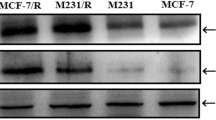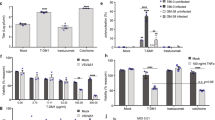Abstract
Conditionally replicating adenoviruses (CRAds) represent a novel approach for the treatment of cancers resistant to conventional therapies. The efficacy of CRAds might be further improved by using chemotherapeutic agents in a multimodal antitumor approach. We have evaluated the use of Ad5/3-Δ24, a serotype 3 receptor targeted Rb/p16 pathway selective CRAd, in combination with gemcitabine against human ovarian adenocarcinoma. The combination of these agents showed synergistic cell killing in vitro compared to single treatments. However, the effect was dependent on dose and sequencing of the agents. Our results also indicate that gemcitabine reduces the initial rate of Ad5/3-Δ24 replication without affecting the total amount of virus produced. Possible reasons for synergy between Ad5/3-Δ24 and gemcitabine include the chemosensitizing activity of E1A and/or altered replication kinetics. In an orthotopic murine model of peritoneally disseminated ovarian cancer, the combination increased the survival of mice over either agent alone, and almost 60% of treated mice were cured. Sequencing of the agents was critical for toxicity versus efficacy. Mice remained free from intraperitoneal disease, but some succumbed to treatment-related hepatic or bone marrow toxicity. This suggests that improved efficacy may uncover treatment-related toxicity, which needs to be monitored closely in clinical trials.
This is a preview of subscription content, access via your institution
Access options
Subscribe to this journal
Receive 12 print issues and online access
$259.00 per year
only $21.58 per issue
Buy this article
- Purchase on Springer Link
- Instant access to full article PDF
Prices may be subject to local taxes which are calculated during checkout





Similar content being viewed by others
References
Jemal A et al. Cancer statistics, 2004. CA Cancer J Clin 2004; 54: 8–29.
Kanerva A, Hemminki A . Modified adenoviruses for cancer gene therapy. Int J Cancer 2004; 110: 475–480.
Bauerschmitz GJ, Barker SD, Hemminki A . Adenoviral gene therapy for cancer: from vectors to targeted and replication competent agents (review). Int J Oncol 2002; 21: 1161–1174.
Kanerva A et al. Targeting adenovirus to the serotype 3 receptor increases gene transfer efficiency to ovarian cancer cells. Clin Cancer Res 2002; 8: 275–280.
Kanerva A et al. Gene transfer to ovarian cancer versus normal tissues with fiber-modified adenoviruses. Mol Ther 2002; 5: 695–704.
Lam JT et al. Inter-patient variation in efficacy of five oncolytic adenovirus candidates for ovarian cancer therapy. J Gene Med 2004; 6: 1333–1342.
Kirn D, Martuza RL, Zwiebel J . Replication-selective virotherapy for cancer: biological principles, risk management and future directions. Nat Med 2001; 7: 781–787.
Fueyo J et al. A mutant oncolytic adenovirus targeting the Rb pathway produces anti-glioma effect in vivo. Oncogene 2000; 19: 2–12.
Sherr CJ . Cancer cell cycles. Science 1996; 274: 1672–1677.
Bauerschmitz GJ et al. Treatment of ovarian cancer with a tropism modified oncolytic adenovirus. Cancer Res 2002; 62: 1266–1270.
Kanerva A et al. Enhanced therapeutic efficacy for ovarian cancer with a serotype 3 receptor-targeted oncolytic adenovirus. Mol Ther 2003; 8: 449–458.
Kanerva A et al. Noninvasive dual modality in vivo monitoring of the persistence and potency of a tumor targeted conditionally replicating adenovirus. Gene Therapy 2005; 12: 87–94.
Fowler Jr WC, Van Le L . Gemcitabine as a single-agent treatment for ovarian cancer. Gynecol Oncol 2003; 90: S21–S23.
Markman M et al. Phase 2 trial of single-agent gemcitabine in platinum-paclitaxel refractory ovarian cancer. Gynecol Oncol 2003; 90: 593–596.
Hecht JR et al. A phase I/II trial of intratumoral endoscopic ultrasound injection of ONYX-015 with intravenous gemcitabine in unresectable pancreatic carcinoma. Clin Cancer Res 2003; 9: 555–561.
Harada T, Enomoto A, Boorman GA, Maronpot RR . Liver and gallbladder. In: Maronpot RR (ed). Pathology of the Mouse: Reference and Atlas. Cache River Press: Vienna, 1999, p 165.
Kanerva A, Hemminki A . Adenoviruses for treatment of cancer. Ann Med (in press).
Kirn D . Clinical research results with dl1520 (Onyx-015), a replication-selective adenovirus for the treatment of cancer: what have we learned? Gene Therapy 2001; 8: 89–98.
Hemminki A et al. A canine conditionally replicating adenovirus for evaluating oncolytic virotherapy in a syngeneic animal model. Mol Ther 2003; 7: 163–173.
Heise C et al. ONYX-015, an E1B gene-attenuated adenovirus, causes tumor-specific cytolysis and antitumoral efficacy that can be augmented by standard chemotherapeutic agents. Nat Med 1997; 3: 639–645.
Heise C, Lemmon M, Kirn D . Efficacy with a replication-selective adenovirus plus cisplatin-based chemotherapy: dependence on sequencing but not p53 functional status or route of administration. Clin Cancer Res 2000; 6: 4908–4914.
You L, Yang CT, Jablons DM . ONYX-015 works synergistically with chemotherapy in lung cancer cell lines and primary cultures freshly made from lung cancer patients. Cancer Res 2000; 60: 1009–1013.
Yu DC et al. Antitumor synergy of CV787, a prostate cancer-specific adenovirus, and paclitaxel and docetaxel. Cancer Res 2001; 61: 517–525.
Li Y et al. A hepatocellular carcinoma-specific adenovirus variant, CV890, eliminates distant human liver tumors in combination with doxorubicin. Cancer Res 2001; 61: 6428–6436.
Khuri FR et al. a controlled trial of intratumoral ONYX-015, a selectively-replicating adenovirus, in combination with cisplatin and 5-fluorouracil in patients with recurrent head and neck cancer. Nat Med 2000; 6: 879–885.
Reid T et al. Hepatic arterial infusion of a replication-selective oncolytic adenovirus (dl1520): phase II viral, immunologic, and clinical endpoints. Cancer Res 2002; 62: 6070–6079.
Hecht JR et al. A phase I/II trial of intratumoral endoscopic ultrasound injection of ONYX-015 with intravenous gemcitabine in unresectable pancreatic carcinoma. Clin Cancer Res 2003; 9: 555–561.
Plunkett W et al. Gemcitabine: metabolism, mechanisms of action, and self-potentiation. Semin Oncol 1995; 22: 3–10.
Orlowski RZ, Baldwin Jr AS . NF-kappaB as a therapeutic target in cancer. Trends Mol Med 2002; 8: 385–389.
Wein LM, Wu JT, Kirn DH . Validation and analysis of a mathematical model of a replication-competent oncolytic virus for cancer treatment: implications for virus design and delivery. Cancer Res 2003; 63: 1317–1324.
Lee WP et al. Adenovirus type 5 E1A sensitizes hepatocellular carcinoma cells to gemcitabine. Cancer Res 2003; 63: 6229–6236.
Shao R et al. Inhibition of nuclear factor-kappaB activity is involved in E1A-mediated sensitization of radiation-induced apoptosis. J Biol Chem 1997; 272: 32739–32742.
Hallden G et al. Novel immunocompetent murine tumor models for the assessment of replication-competent oncolytic adenovirus efficacy. Mol Ther 2003; 8: 412–424.
Hemminki A et al. Modulation of coxsackie-adenovirus receptor expression for increased adenoviral transgene expression. Cancer Res 2003; 63: 847–853.
Sirena D et al. The human membrane cofactor CD46 is a receptor for species B adenovirus serotype 3. J Virol 2004; 78: 4454–4462.
Gaggar A, Shayakhmetov DM, Lieber A . CD46 is a cellular receptor for group B adenoviruses. Nat Med 2003; 9: 1408–1412.
Chou TC, Talalay P . Analysis of combined drug effects: a new look at a very old problem. Trends Pharmacol Sci 1983; 4: 450–454.
Tonkinson JL, Worzalla JF, Teng CH, Mendelsohn LG . Cell cycle modulation by a multitargeted antifolate, LY231514, increases the cytotoxicity and antitumor activity of gemcitabine in HT29 colon carcinoma. Cancer Res 1999; 59: 3671–3676.
Acknowledgements
We thank Eli Lilly and Co. for providing gemcitabine. This work was supported by the Academy of Finland, Helsinki University Central Hospital Research Funds, University of Helsinki Internal Funds, Sohlberg Foundation, Emil Aaltonen Foundation, Biocentrum Helsinki, Sigrid Juselius Foundation, Ida Montin Foundation, Finnish Cancer Society, Finnish Oncology Association, Instrumentarium Research Fund, Research and Science Foundation Farmos, City of Kotka Research Funds, and Regional Funds of the Finnish Cultural Foundation.
Author information
Authors and Affiliations
Rights and permissions
About this article
Cite this article
Raki, M., Kanerva, A., Ristimaki, A. et al. Combination of gemcitabine and Ad5/3-Δ24, a tropism modified conditionally replicating adenovirus, for the treatment of ovarian cancer. Gene Ther 12, 1198–1205 (2005). https://doi.org/10.1038/sj.gt.3302517
Received:
Accepted:
Published:
Issue Date:
DOI: https://doi.org/10.1038/sj.gt.3302517
Keywords
This article is cited by
-
Understanding and addressing barriers to successful adenovirus-based virotherapy for ovarian cancer
Cancer Gene Therapy (2021)
-
Tumor-specific oncolytic adenoviruses expressing granulocyte macrophage colony-stimulating factor or anti-CTLA4 antibody for the treatment of cancers
Cancer Gene Therapy (2014)
-
Synergistic cytotoxicity of radiation and oncolytic Lister strain vaccinia in V600D/EBRAF mutant melanoma depends on JNK and TNF-α signaling
Oncogene (2014)
-
Oncolytic Adenovirus With Temozolomide Induces Autophagy and Antitumor Immune Responses in Cancer Patients
Molecular Therapy (2013)
-
Combination of a MDR1-targeted replicative adenovirus and chemotherapy for the therapy of pretreated ovarian cancer
Journal of Cancer Research and Clinical Oncology (2012)



